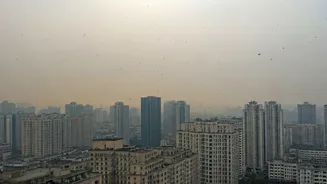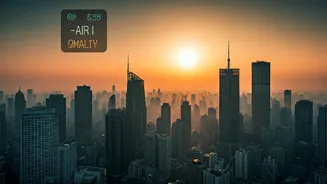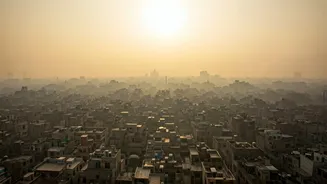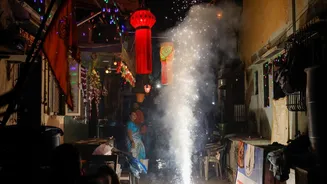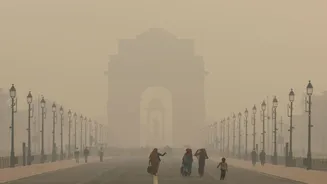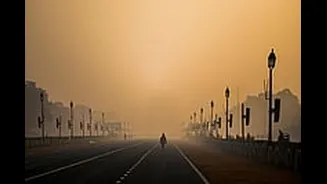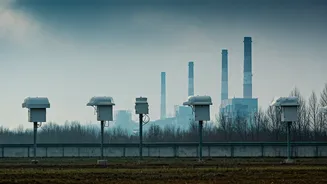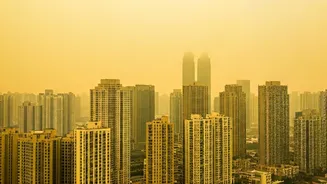Diwali's Environmental Fallout
Diwali, the festival of lights, is a cherished occasion celebrated with great enthusiasm across India. However, the use of fireworks and other activities
during the festival often results in a significant deterioration of air quality. In Delhi, this phenomenon is particularly pronounced. The burning of firecrackers releases a wide array of pollutants into the atmosphere, including particulate matter, nitrogen oxides, and sulfur dioxide. These substances contribute to a thick smog that can linger for days, causing health problems for residents. Moreover, the meteorological conditions during and after Diwali, such as low wind speeds and temperature inversions, can trap pollutants close to the ground, exacerbating the problem. Monitoring air quality in the days following the festival provides a crucial insight into the environmental impact of these celebrations.
Top 10 Polluted Areas
The air quality data collected after Diwali revealed a concerning situation in several parts of Delhi. A list of the ten most polluted areas highlights the severity of the problem. These areas often experience extremely high concentrations of particulate matter (PM2.5 and PM10), exceeding safe levels by several times. The specific locations on the list might vary slightly depending on the monitoring stations' data. Residential areas and those with high traffic density tend to be disproportionately affected. Industrial zones, too, contribute significantly to pollution levels. Public awareness campaigns and stringent enforcement of pollution control measures are therefore essential to mitigate the adverse health impacts of the post-Diwali air quality crisis.
Understanding PM2.5 and PM10
Particulate matter, typically referred to as PM2.5 and PM10, is a major component of air pollution. PM2.5 refers to fine inhalable particles with a diameter of 2.5 micrometers or less, while PM10 includes particles with a diameter of 10 micrometers or less. Both types can penetrate deep into the respiratory system, causing a range of health issues. PM2.5 is especially concerning because of its ability to travel deep into the lungs and even enter the bloodstream. Exposure to high levels of PM2.5 and PM10 can lead to respiratory infections, asthma exacerbations, cardiovascular diseases, and other serious health problems. Monitoring these pollutants is essential for evaluating air quality and protecting public health, with elevated levels directly linked to increased morbidity and mortality, especially in vulnerable populations such as children, the elderly, and those with pre-existing conditions.
Health Risks & Impacts
The elevated levels of air pollution following Diwali pose significant health risks to Delhi residents. Exposure to the polluted air can trigger or worsen respiratory illnesses such as asthma and bronchitis. People with pre-existing respiratory conditions, children, and the elderly are particularly vulnerable. The tiny particles in the air can also cause cardiovascular problems, including heart attacks and strokes. Moreover, long-term exposure to air pollution is linked to an increased risk of cancer and other serious diseases. The impact extends beyond health, affecting the overall quality of life by causing eye irritation, throat infections, and reduced visibility. Public health advisories and the adoption of preventive measures become critically important to reduce these health impacts during periods of high pollution.
Governmental Response & Measures
Government authorities respond to post-Diwali pollution with a variety of measures to control and mitigate the environmental impact. The implementation of stricter regulations on industrial emissions is a key strategy. The enforcement of a ban on firecrackers, along with promoting public awareness campaigns regarding the health hazards of air pollution, are critical. Further actions include promoting the use of public transportation and encouraging the adoption of cleaner fuels for vehicles to reduce emissions. The government also works to monitor air quality data and issue public health advisories to protect vulnerable populations. The effectiveness of these measures depends on rigorous enforcement, public cooperation, and continuous monitoring to assess the outcomes and adjust strategies as needed. Collaboration between various agencies and active participation from the citizens is vital for achieving meaningful improvements in air quality.
